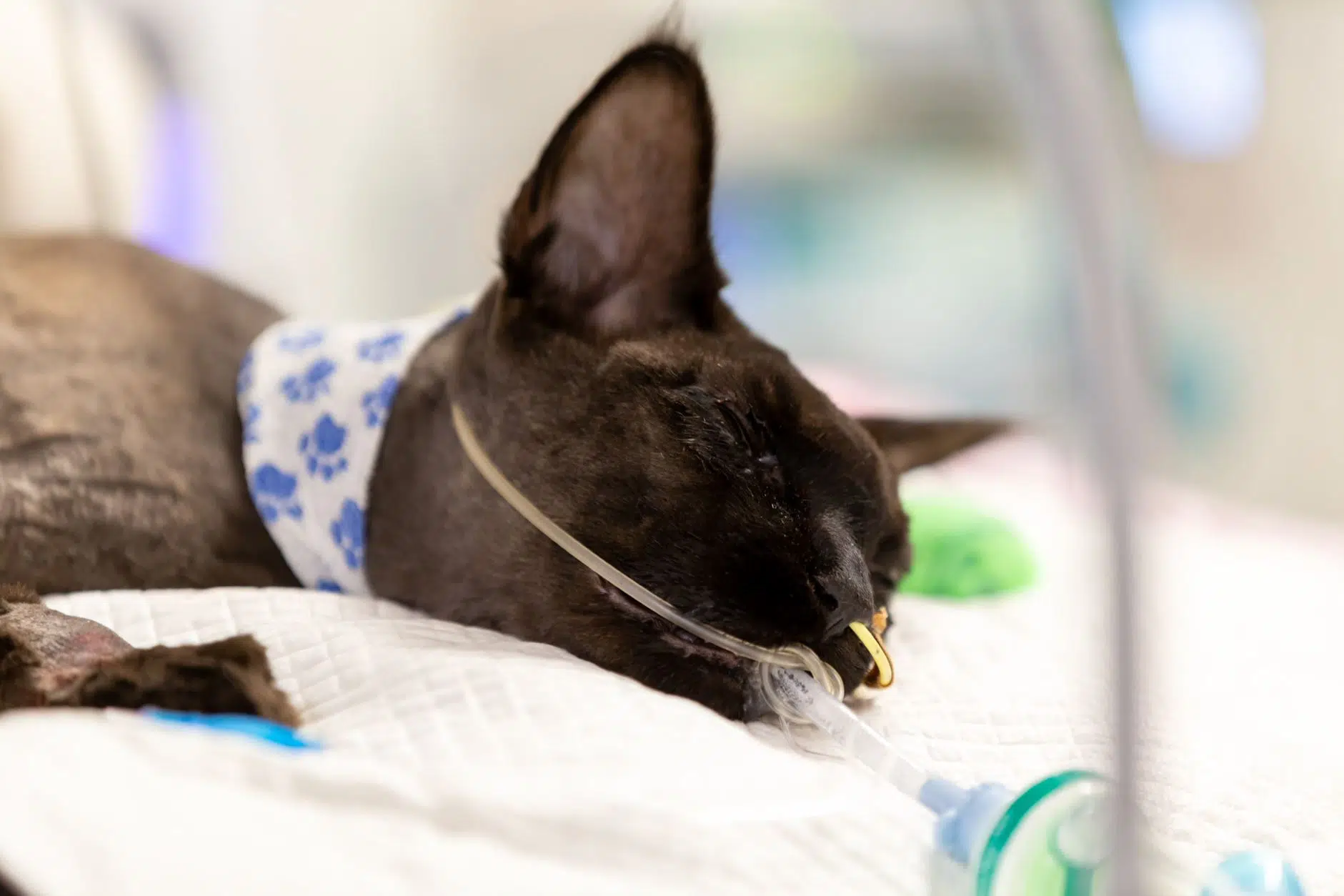In our last tick paralysis article, our clinical focus was on tick anti-serum (TAS), which is a vital piece in the puzzle of managing any tick paralysis patient. This time we’ll be focusing on managing tick paralysis respiratory disease. While effective treatment certainly requires quick intervention and management of paralysis through administration of anti-serum, it’s important to acknowledge the wider impacts of paralysis, particularly those which impact a patient’s ability to respire.

At triage, respiratory function should be assessed immediately – those animals with severe respiratory distress or cyanosis should be taken straight to the treatment room and treated with flow-by oxygen. These animals will generally have severe anxiety and will benefit from sedation.
Respiratory Support
Respiratory failure in tick paralysis is a complex problem for the tick paralysis patient beyond paralysis of the respiratory muscles, which is often the primary concern. As respiratory compromise is multifactorial, it is related to several different mechanisms, all of which must be considered:
- Increased oxygen consumption associated with increased respiratory effort and stress
- Fatigue/paralysis of thoracic respiratory muscles leading to reduced ventilation
- Laryngeal dysfunction leading to upper airway obstruction
- Pulmonary compromise resulting from aspiration and/or cardiac dysfunction
Multiple therapies need to be implemented to effectively manage this, especially in a severe case, including immediate oxygen supplementation. Sedation or anaesthesia is a mainstay of treatment, second only to the anti-serum, and almost always indicated before anti-serum administration. Anxiety or stress results in increased oxygen consumption (by 50-100%), predisposing patients to respiratory muscle fatigue and increasing the risk of aspiration. Aggressive and early use of sedation can be lifesaving.
But with so many options available for sedation, which is the most appropriate to use in your patient?
Sedation
At AEA, we see hundreds of tick paralysis patients, and while sedation should be catered to the individual patient, there are a select few that we often rely upon for most of our cases. These are highlighted in bold below as the drugs we most commonly choose for tick paralysis sedation. Choices of which sedative to use include:
- Acepromazine 0.01 – 0.05 mg/kg IV or SC (maximum of 2 mg total dose, take into account patient’s age and health status, administer slowly IV if possible)
- Butorphanol 0.2 – 0.6 mg/kg IV or SC, CRI of 0.1 mg/kg/hr (put 10-20 mg in a 1 L fluid bag and run at maintenance (0.1-0.3mg/kg/hr)
- Methadone 0.1 – 0.3 mg/kg IV or SQ
- Buprenorphine 10-30ug/kg IV or SQ (mainly for cats, use with ACP or diazepam, takes about 30 minutes to take effect)
- Diazepam 0.1-0.2 mg/kg IV or IM (use with an opioid)
- Midazolam 0.1-0.3 mg/kg/hr (use with a butorphanol CRI, can result in profound sedation/stage 1 anaesthesia)
Anaesthesia
For patients requiring mechanical ventilation, anaesthesia may also be necessary. As with sedation, a wide range of options are available, but certain medications that are less likely to cause respiratory depression should be considered. Options for anaesthetic medications are listed below, with those in bold as the choices we often opt for at AEA:
- Propofol 0.05 – 0.6 mg/kg/min with midazolam +/- butorphanol
- Start at about 0.1 mg/kg, often when used in combination with an opioid and benzodiazepine only small amounts are needed making it moderately cost effective. Watch for the cumulative effect in cats, and high doses will cause significant lipaemia. For this reason, alfaxalone is the preferred drug in cats.
- Alfaxan 1-2mg/kg/hr (undocumented dose).
- Very expensive and appears to cause respiratory depression comparable to propofol, though spares cardiovascular function.
- Thiopentone – loading dose of 4-10mg/kg then 1-4 mg/kg/hr.
- Effects are cumulative so close monitoring and dose reduction is required.
- Pentobarbitone – 2-6 mg/kg/hr
- Effects are cumulative so close monitoring and dose reduction is required. If administered for longer then 3 days, may seizure on wakeup to minimize this transfer to propofol 24-36 hours before wakeup.
- Fentanyl – 4-10ug/kg/hr
- Dose above is appropriate when used in combination with midazolam. Cardiovascularly stable and quick to wind down/up, but expensive.
Mechanical Ventilation
Animals that are unable to maintain a respiratory rate greater than 10-12 breaths per minute, or any that cannot maintain oxygen saturation at an adequate level with sedation and oxygen therapy will require anaesthetisation with intubation +/- ventilation. The ability to use blood gas, pulse oximetry and capnography allow close monitoring of respiratory function. Arterial oxygen partial pressure (PaO2) of 60 mmHg is the minimum acceptable in animals on oxygen supplementation before intubation +/- ventilation is required (this equates to an SPO2 of 90%).

Mechanical ventilation is usually successful in animals with poor respiratory function, but minimal pulmonary pathology, as is seen in the earlier phases of respiratory failure in patients with tick paralysis. If you work in a clinic with no access to a ventilator but have the ability to refer to a hospital that does, it may be worth considering if/when referral will be necessary for each patient.
Aspiration Pneumonia
Any tick paralysis patient is at an increased risk of aspiration pneumonia. Animals that show a marked deterioration in respiratory status, which is not explained by respiratory muscle fatigue or paralysis, or have detectable increased bronchovesicular sounds and crackles on auscultation, require chest radiographs to document the pathological process and treat appropriately. A patient with a perihilar interstitial to alveolar pattern may benefit from load reduction using a diuretic (furosemide 1-2mg/kg IV), as well as anti-arrhythmic or positive inotropes.

In addition to antibiotic therapy, intravenous fluids are required to help moisten airway secretions to allow removal from the lungs. This can be assisted with nebulisation and coupage, as long as it does not stress the patient. It is likely that recommendations for antibiotic administration and collection of fluid samples for culture will change as we continue to develop these protocols.
Now that your patient treated with anti-serum and receiving adequate respiratory support, it’s now time to consider additional supportive care options that can maximise your chance of success in treating every tick paralysis patient. Find out how you can continue to help your patient and what supportive care offers the most favourable outcome in our next article or access the tick protocol in full at VetAPedia.




